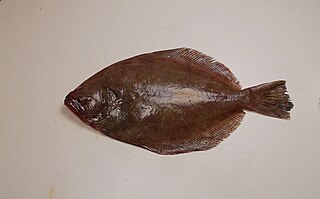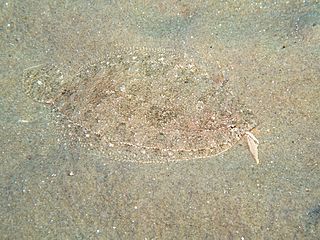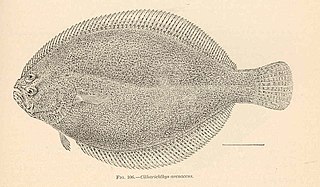
Flounders are a group of flatfish species. They are demersal fish, found at the bottom of oceans around the world; some species will also enter estuaries.

A flatfish is a member of the ray-finned demersal fish order Pleuronectiformes, also called the Heterosomata, sometimes classified as a suborder of Perciformes. In many species, both eyes lie on one side of the head, one or the other migrating through or around the head during development. Some species face their left sides upward, some face their right sides upward, and others face either side upward.

Pleuronectidae, also known as righteye flounders, are a family of flounders. They are called "righteye flounders" because most species lie on the sea bottom on their left sides, with both eyes on their right sides. The Paralichthyidae are the opposite, with their eyes on the left side. A small number of species in Pleuronectidae can also have their eyes on the left side, notably the members of the genus Platichthys.

Large-tooth flounders or sand flounders are a family, Paralichthyidae, of flounders. The family contains 14 genera with a total of about 110 species. They lie on the sea bed on their right side; both eyes are always on the left side of the head, while the Pleuronectidae usually have their eyes on the right side of the head.

The witch, Arnoglossus scapha, is a lefteye flounder of the family Bothidae, found around China and New Zealand, in waters less than 400 m in depth. Their length is from 20 to 40 cm.

The lined sole is a ray-finned flatfish found in the Western Atlantic. Its common length is 17 cm. Often considered a trash fish in commercial trawling, it is of little or no economic value.

Paralichthys lethostigma, the southern flounder, is a species of large-tooth flounder native to the East Coast of the United States and the northern Gulf of Mexico. It is a popular sport fish and is the largest and most commercially valuable flounder in the western North Atlantic Ocean and Gulf of Mexico. It is a "left-eyed flounder", meaning the left side is pigmented and is the "up side".

Platichthys is a genus of flatfish native to the North Pacific and North Atlantic oceans. Despite being in the family Pleuronectidae, all three species in the genus Platichthys are often "lefteyed", i.e. they lie on the sea bottom on their right side, with both eyes on the left side.

The blackfin flounder is a flatfish of the family Pleuronectidae. It is a demersal fish that lives in temperate waters at depths of between 8 and 1,600 metres, though it is most commonly found between 15 and 800 metres. Its native habitat is the northern Pacific, from the Sea of Japan to the Strait of Tartary and southern Kuril Islands and out into the Bering Sea. It grows up to 52 centimetres (20 in) in length, and can weigh up to 1.5 kilograms (3.3 lb). Maximum reported lifespan is 23 years.

The peacock flounder, also known as the flowery flounder, is a species of fish in the family Bothidae. The species is found widely in relatively shallow waters in the Indo-Pacific, also ranging into warmer parts of the East Pacific.

Bothus is a genus of flatfish in the family Bothidae from the Pacific, Indian and Atlantic Oceans. Some species in this genus have spots consisting of blue rings.

Chascanopsetta is a genus of flatfish in the family Bothidae found in deeper parts of the Pacific and Indian Oceans with a single species, C. lugubris also occurring in the Atlantic Ocean. It contains nine member species.
Citharichthys amblybregmatus is a species of flatfish in the large-tooth flounder family Paralichthyidae. It is native to the western north Atlantic Ocean. It has been collected at a depth of 198 m (650 ft).

The scaldfishes comprise a genus, Arnoglossus, of lefteye flounders. They are found in the Pacific, Indian and Atlantic Oceans, including the Mediterranean and Black Sea. They are entirely absent from most of the Americas; the only exceptions are A. coeruleosticta and A. multirastris found off Chile. The genus include both species found in shallow and deeper water. The largest species reaches 28 cm (11 in).

Engyprosopon is a genus of small lefteye flounders. They are found in the Indo-Pacific, ranging from shallow coastal waters to depths in excess of 400 m (1,300 ft).

Thor's scaldfish is a species of bottom feeder benthic fish belonging to the family Bothidae. It is widespread in the Eastern Atlantic from Ireland to Sierra Leone and Cape Verde, and also known from the western Mediterranean and Black Sea. It is a marine, subtropical, demersal fish, up to 18 cm long.

Citharichthys cornutus, the horned whiff, is a species of flatfish in the large-tooth flounder family Paralichthyidae. This bathydemersal marine fish inhabits the continental shelves of the western Atlantic Ocean, in both tropical and subtropical waters. It ranges from New Jersey in the north to Uruguay in the south, though larvae samples have also been collected off the coast of Canada. It occurs at depths between 30 and 400 metres, though it is usually found in deeper waters.

Citharichthys arenaceus, the sand whiff, is a species of flatfish in the large-tooth flounder family Paralichthyidae. This demersal marine fish inhabits the western Atlantic Ocean, occurring in shallow tropical coastal waters, as well as in estuaries, bays, and lagoons. It ranges from Florida, United States, in the north to the West Indies and Brazil in the south.

The eyed flounder is a species of fish in the family Bothidae. The species is found on or near the sandy seabed in relatively shallow waters in the western Atlantic Ocean, the Caribbean Sea and the Gulf of Mexico.

Etropus microstomus, the smallmouth flounder, is a species of fish belonging to the family Paralichthyidae.





























